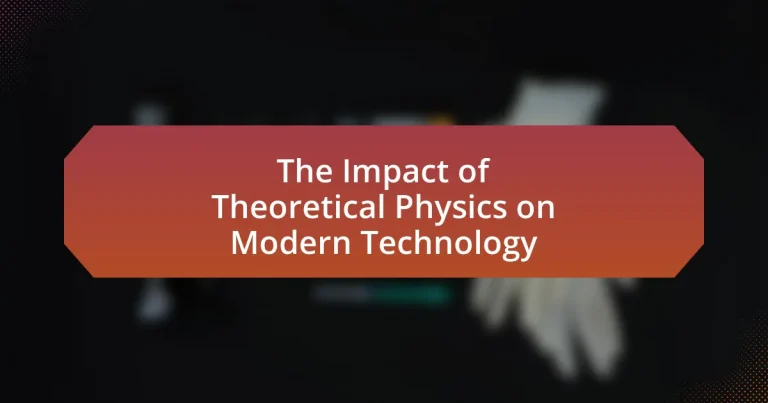The article examines the significant impact of theoretical physics on modern technology, highlighting its foundational role in advancements across various fields such as electronics, telecommunications, and medical imaging. Key principles, including quantum mechanics and relativity, are explored for their contributions to technologies like semiconductors, GPS systems, and MRI machines. The relationship between theoretical models and practical applications is emphasized, showcasing how theoretical physics drives innovation and shapes contemporary technological landscapes. Additionally, the article discusses emerging technologies and future implications of theoretical physics in areas like energy production and materials science.

What is the Impact of Theoretical Physics on Modern Technology?
The impact of theoretical physics on modern technology is profound, as it underpins many advancements in fields such as electronics, telecommunications, and medical imaging. The principles of quantum mechanics, a branch of theoretical physics, have led to the development of semiconductors, which are essential for computers and smartphones. Additionally, theories related to electromagnetism have facilitated the creation of wireless communication technologies, including Wi-Fi and cellular networks.
Moreover, theoretical physics has significantly influenced medical technologies; for instance, MRI machines rely on principles of nuclear magnetic resonance, which stem from theoretical physics research. Theoretical frameworks also guide innovations in materials science, leading to the development of new materials like graphene, which has potential applications in various technologies. Thus, the contributions of theoretical physics are integral to the technological landscape we experience today.
How has theoretical physics shaped technological advancements?
Theoretical physics has significantly shaped technological advancements by providing foundational principles that underpin modern technologies. For instance, the development of quantum mechanics led to the invention of semiconductors, which are crucial for computers and smartphones. Additionally, Einstein’s theory of relativity has been instrumental in the development of GPS technology, as it accounts for time dilation effects that occur due to differences in gravitational fields and speeds. These advancements demonstrate how theoretical physics not only enhances our understanding of the universe but also drives practical applications that transform everyday life.
What are the key principles of theoretical physics that influence technology?
The key principles of theoretical physics that influence technology include quantum mechanics, relativity, and thermodynamics. Quantum mechanics underpins technologies such as semiconductors and lasers, enabling advancements in electronics and communication. Relativity, particularly Einstein’s theories, has practical applications in GPS technology, where satellite positioning relies on relativistic corrections to maintain accuracy. Thermodynamics governs energy systems and efficiency, impacting everything from engines to refrigeration. These principles are foundational in developing modern technologies, demonstrating their critical role in shaping contemporary innovations.
How do theoretical models translate into practical applications?
Theoretical models translate into practical applications by providing a framework for understanding complex phenomena, which can then be utilized to develop technologies and solutions. For instance, the principles of quantum mechanics, a theoretical model, have led to the creation of semiconductors and lasers, which are foundational to modern electronics and communication systems. This translation occurs through a process of experimentation and validation, where predictions made by theoretical models are tested in real-world scenarios, leading to innovations such as MRI machines in medical imaging, which rely on the principles of nuclear magnetic resonance derived from theoretical physics.
Why is the relationship between theoretical physics and technology significant?
The relationship between theoretical physics and technology is significant because theoretical physics provides the foundational principles that drive technological advancements. For instance, the development of quantum mechanics, a branch of theoretical physics, has led to innovations such as semiconductors and lasers, which are essential for modern electronics and telecommunications. Historical evidence shows that breakthroughs in theoretical physics, like Einstein’s theory of relativity, have also influenced technologies such as GPS systems, which rely on relativistic corrections for accurate positioning. Thus, the interplay between theoretical physics and technology not only fosters innovation but also enhances our understanding of the universe, leading to practical applications that transform society.
What historical examples illustrate this relationship?
The relationship between theoretical physics and modern technology is illustrated by the development of quantum mechanics and its application in semiconductors. Quantum mechanics, formulated in the early 20th century by physicists such as Max Planck and Niels Bohr, laid the groundwork for understanding atomic and subatomic processes. This theoretical framework directly enabled the invention of transistors in the 1940s, which revolutionized electronics by allowing for the miniaturization of circuits and the development of computers. The impact is evident as the semiconductor industry, which relies on principles of quantum mechanics, has grown into a multi-trillion-dollar sector, fundamentally transforming communication, computing, and numerous other technologies.
How does this relationship drive innovation in various fields?
The relationship between theoretical physics and modern technology drives innovation by providing foundational principles that lead to practical applications across various fields. For instance, concepts from quantum mechanics have enabled advancements in semiconductor technology, which is crucial for the development of computers and smartphones. The invention of the transistor, a direct application of quantum theory, revolutionized electronics and led to the information age, demonstrating how theoretical insights can translate into transformative technologies. Additionally, theories in relativity have influenced GPS technology, ensuring accurate positioning by accounting for time dilation effects. These examples illustrate that the interplay between theoretical physics and technology fosters continuous innovation, enhancing capabilities in sectors such as telecommunications, computing, and navigation.

What are the specific technologies influenced by theoretical physics?
Specific technologies influenced by theoretical physics include quantum computing, GPS technology, and medical imaging techniques such as MRI. Quantum computing relies on principles of quantum mechanics, enabling faster processing and complex problem-solving capabilities. GPS technology utilizes the theory of relativity to provide accurate positioning by accounting for time dilation effects experienced by satellites. Medical imaging techniques like MRI are based on nuclear magnetic resonance, a concept derived from quantum physics, allowing for detailed internal imaging of the human body. These technologies demonstrate the profound impact of theoretical physics on practical applications in various fields.
How do quantum mechanics contribute to modern technology?
Quantum mechanics significantly contribute to modern technology by enabling advancements in various fields such as computing, telecommunications, and medical imaging. For instance, quantum mechanics underpins the operation of semiconductors, which are essential for electronic devices, including smartphones and computers. The principles of quantum superposition and entanglement are also foundational to the development of quantum computers, which have the potential to perform complex calculations much faster than classical computers. Additionally, quantum mechanics is crucial in technologies like MRI machines, which utilize quantum principles to produce detailed images of the human body. These contributions demonstrate the profound impact of quantum mechanics on the functionality and efficiency of contemporary technological applications.
What are the applications of quantum computing in today’s world?
Quantum computing has applications in optimization, cryptography, drug discovery, and materials science. In optimization, quantum algorithms can solve complex problems more efficiently than classical computers, as demonstrated by D-Wave’s quantum annealers used in logistics and supply chain management. In cryptography, quantum computing poses a threat to traditional encryption methods, leading to the development of quantum-resistant algorithms, as highlighted by the National Institute of Standards and Technology’s ongoing post-quantum cryptography standardization process. In drug discovery, quantum simulations can model molecular interactions at unprecedented accuracy, which companies like IBM and Google are exploring to accelerate the development of new pharmaceuticals. Lastly, in materials science, quantum computing enables the simulation of new materials with unique properties, as evidenced by research from institutions like MIT and Stanford, which aim to discover superconductors and other advanced materials.
How does quantum theory impact telecommunications and encryption?
Quantum theory significantly impacts telecommunications and encryption by enabling the development of quantum communication technologies, such as quantum key distribution (QKD). QKD utilizes principles of quantum mechanics, specifically the behavior of quantum bits (qubits), to create secure communication channels that are theoretically immune to eavesdropping. For instance, any attempt to intercept the quantum keys alters their state, alerting the communicating parties to potential security breaches. This was demonstrated in experiments like the 2017 satellite-based QKD conducted by the Chinese Academy of Sciences, which successfully transmitted quantum keys over distances exceeding 4,600 kilometers. Thus, quantum theory not only enhances the security of telecommunications but also revolutionizes encryption methods, making them more robust against future threats posed by advancements in classical computing.
What role does relativity play in contemporary technology?
Relativity plays a crucial role in contemporary technology, particularly in the functioning of global positioning systems (GPS). GPS satellites rely on both special and general relativity to provide accurate location data; the effects of time dilation due to their high speeds and the gravitational field of Earth must be accounted for. Without these corrections, GPS measurements would drift by about 10 kilometers each day, rendering the system ineffective. This demonstrates how the principles of relativity are essential for the precision and reliability of modern navigation technologies.
How does GPS technology rely on principles of relativity?
GPS technology relies on the principles of relativity to ensure accurate positioning and timing. The system incorporates both special relativity and general relativity; special relativity accounts for the time dilation experienced by satellites moving at high speeds relative to observers on Earth, while general relativity addresses the gravitational time dilation due to the weaker gravitational field in orbit compared to Earth’s surface.
For instance, satellites in the GPS network experience time at a different rate than clocks on Earth, leading to a discrepancy of about 38 microseconds per day. This difference is corrected to maintain the precision required for GPS functionality, which relies on accurate timing to triangulate positions. Without these relativistic adjustments, GPS calculations would yield significant errors, potentially leading to positioning inaccuracies of several kilometers.
What are the implications of relativity in satellite communications?
The implications of relativity in satellite communications are significant, primarily affecting the accuracy of timekeeping in satellite systems. Due to the effects of both special and general relativity, satellites experience time dilation; they move at high speeds relative to the Earth and are also in a weaker gravitational field. This results in satellite clocks running faster than those on Earth by approximately 38 microseconds per day.
To maintain precise positioning and timing, the Global Positioning System (GPS) must account for these relativistic effects. If uncorrected, the discrepancies would lead to navigational errors of about 10 kilometers per day. Thus, the integration of relativity into satellite technology is essential for ensuring the reliability and accuracy of satellite communications and navigation systems.

How can we see the future impact of theoretical physics on technology?
The future impact of theoretical physics on technology can be observed through advancements in quantum computing, which relies on principles of quantum mechanics. Quantum computing promises to revolutionize data processing speeds and capabilities, enabling complex problem-solving that classical computers cannot achieve. For instance, Google’s quantum computer, Sycamore, demonstrated quantum supremacy in 2019 by solving a problem in 200 seconds that would take the most powerful supercomputers approximately 10,000 years. This illustrates how theoretical physics directly informs technological innovation, leading to practical applications in cryptography, materials science, and artificial intelligence.
What emerging technologies are being developed from theoretical physics concepts?
Emerging technologies developed from theoretical physics concepts include quantum computing, advanced materials, and gravitational wave detection. Quantum computing leverages principles of superposition and entanglement to perform calculations at unprecedented speeds, with companies like IBM and Google leading the research. Advanced materials, such as graphene and metamaterials, are derived from quantum mechanics and have applications in electronics and optics, as evidenced by research from institutions like MIT. Gravitational wave detection, based on Einstein’s theory of general relativity, has led to the development of observatories like LIGO, which confirmed the existence of gravitational waves in 2015, opening new avenues in astrophysics and cosmology.
How might advancements in theoretical physics change energy production?
Advancements in theoretical physics could revolutionize energy production by enabling the development of new energy sources, such as fusion energy and quantum batteries. For instance, research into nuclear fusion, which mimics the processes powering the sun, has the potential to provide a nearly limitless and clean energy source, as demonstrated by projects like ITER, which aims to achieve sustainable fusion reactions. Additionally, theoretical advancements in quantum mechanics could lead to the creation of quantum batteries, which promise faster charging and higher energy density compared to conventional batteries. These innovations could significantly reduce reliance on fossil fuels and enhance energy efficiency, thereby transforming the global energy landscape.
What potential breakthroughs could arise in materials science from theoretical physics?
Potential breakthroughs in materials science from theoretical physics include the development of superconductors at room temperature, which could revolutionize energy transmission and storage. Theoretical physics provides the framework for understanding quantum mechanics and condensed matter physics, leading to the prediction of new materials with unique properties. For instance, research has identified topological insulators, which have applications in quantum computing and spintronics, demonstrating how theoretical insights can guide experimental discoveries. Additionally, advancements in nanomaterials, driven by theoretical models, enable the creation of stronger, lighter, and more efficient materials for various applications, from aerospace to electronics.
What best practices can be adopted to leverage theoretical physics in technology development?
To leverage theoretical physics in technology development, best practices include fostering interdisciplinary collaboration, investing in research and development, and applying theoretical models to practical problems. Interdisciplinary collaboration allows physicists to work with engineers and technologists, enhancing innovation; for instance, the collaboration between physicists and computer scientists has led to advancements in quantum computing. Investing in research and development is crucial, as evidenced by the significant funding allocated to projects like the Large Hadron Collider, which has driven technological advancements in various fields. Lastly, applying theoretical models, such as those from quantum mechanics, to real-world applications can lead to breakthroughs in materials science and nanotechnology, demonstrating the practical utility of theoretical physics in developing new technologies.
How can interdisciplinary collaboration enhance technological innovation?
Interdisciplinary collaboration enhances technological innovation by integrating diverse expertise and perspectives, which fosters creative problem-solving and accelerates the development of new technologies. For instance, the collaboration between physicists, engineers, and computer scientists has led to advancements in quantum computing, where theoretical physics principles are applied to create more efficient algorithms and hardware. Research from the National Academy of Sciences highlights that interdisciplinary teams are more likely to produce high-impact innovations, as they combine knowledge from different fields to address complex challenges. This synergy not only leads to novel solutions but also drives economic growth and societal benefits through the commercialization of innovative technologies.
What strategies can researchers use to translate theoretical concepts into practical solutions?
Researchers can use interdisciplinary collaboration, prototyping, and iterative testing to translate theoretical concepts into practical solutions. Interdisciplinary collaboration allows researchers to combine insights from various fields, enhancing the applicability of theoretical concepts. For instance, physicists working with engineers can develop technologies like MRI machines, which rely on principles of quantum mechanics. Prototyping enables researchers to create tangible models of their theories, facilitating real-world testing and refinement. Iterative testing further allows for the continuous improvement of these prototypes based on empirical data, ensuring that the final solutions are both effective and practical. This approach is evidenced by the development of semiconductor technology, which emerged from theoretical physics and has revolutionized modern electronics.




